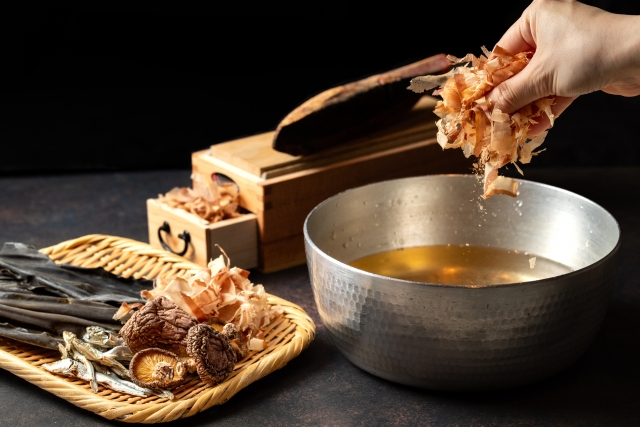When people think of Japanese food, sushi or ramen might come to mind. But behind the scenes, many dishes are brought to life by a quiet hero: dashi (出汁).
So, what exactly is dashi?
Dashi: A Simple, Umami-Rich Stock
Dashi is a clear broth that forms the base of many Japanese dishes. It’s light, subtle, and full of umami — the savory taste that enhances other flavors without overwhelming them.
Dashi is what gives miso soup its comfort, udon its soul, and simmered vegetables their gentle depth. Without dashi, Japanese cuisine wouldn’t be the same.
One Ingredient or More: The Types of Dashi
Dashi can be made from just one ingredient, or from a combination of two to create what’s called awase dashi(combined dashi). While mixing ingredients can add depth, it’s generally recommended to limit the combination to two sources of umami. Too many can create an unbalanced or muddy flavor.
Common dashi ingredients include:
- Kombu (dried kelp) – rich in glutamic acid
- Katsuobushi (dried bonito flakes) – full of inosinic acid
- Niboshi (dried anchovies or sardines) – strong flavor, also rich in inosinic acid
- Dried shiitake mushrooms – contain guanylic acid, offering earthy umami
By combining ingredients with different types of umami compounds (like kombu + katsuobushi), you create synergy — a richer, more complex flavor than either could produce alone.
How to Make Dashi Using Niboshi (Dried Fish)
Let’s walk through how to make niboshi dashi:
- Remove the heads and guts from the niboshi if you prefer a cleaner taste. (Leaving them in gives a stronger, more intense flavor. You know I’m lazy, I just leave them and they come out great!)
- Add 20–30g of niboshi to 1 liter of cold water.
- Let it soak for a few hours or overnight to extract the flavor gently. Package of niboshi I bought said at least 5 hours, but it’s up to you.
- Then, heat the pot over medium heat.
- Once the water comes to a boil, reduce to low heat and skim off any scum (aku) that rises to the surface.
- Simmer gently for 5–10 minutes, then remove the niboshi.
- Strain and your dashi is ready to use!
This results in a clean, ocean-scented broth with rich umami — perfect for miso soup or simmered dishes. Let me note that this dashi itself doesn’t taste that good. You need to combine this dashi with some other flavor. It’s mysteriously wonderful how dashi enhances other flavors, like 1+1 isn’t just 2, but more like 10!
A Note on Water
Dashi develops best in soft water, which is naturally common in Japan. If your local tap water is hard, using filtered or bottled soft water can really help bring out the umami.
How to Use Dashi
Dashi is incredibly versatile. You can use it for:
- Miso soup
- Clear soups (osuimono)
- Udon or soba broth (mentsuyu)
- Chawanmushi (savory egg pudding)
- Nimono (simmered dishes)
- Tamagoyaki (Japanese omelet)
Even when you don’t have time to make it from scratch, granulated dashi or dashi packs are convenient and still delicious. It’s all about finding the right balance between flavor and ease in daily cooking.
Why Dashi Matters
Dashi isn’t just broth — it represents simplicity, seasonality, and respect for ingredients in Japanese cuisine. With just water and one or two thoughtfully chosen ingredients, you can create a base that transforms your cooking.
In a future article, I’ll dive deeper into different types of dashi and how to make the most of each one.
But for now, remember: if your Japanese dish feels like it’s missing something, it’s probably dashi.


